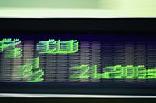
 |
|
| Financial Terms | |
| Effective spread |
|
Information about financial, finance, business, accounting, payroll, inventory, investment, money, inventory control, stock trading, financial advisor, tax advisor, credit.
Main Page: inventory control, inventory, business, financial advisor, credit, tax advisor, financial, accounting, |
Definition of Effective spread
Effective spreadThe gross underwriting spread adjusted for the impact of the announcement of the common
Related Terms:Bull spreadA spread strategy in which an investor buys an out-of-the-money put option, financing it by Credit spreadRelated:Quality spread Effective annual interest rateAn annual measure of the time value of money that fully reflects the effects of Effective annual yieldAnnualized interest rate on a security computed using compound interest techniques. Effective call priceThe strike price in an optional redemption provision plus the accrued interest to the Effective convexityThe convexity of a bond calculated with cash flows that change with yields. Effective dateIn an interest rate swap, the date the swap begins accruing interest.  Effective durationThe duration calculated using the approximate duration formula for a bond with an Effective margin (EM)Used with SAT performance measures, the amount equaling the net earned spread, or Effective rateA measure of the time value of money that fully reflects the effects of compounding. Gross spreadThe fraction of the gross proceeds of an underwritten securities offering that is paid as Horizontal spreadThe simultaneous purchase and sale of two options that differ only in their exercise date. Intermarket spread swapsAn exchange of one bond for another based on the manager's projection of a Intramarket sector spreadThe spread between two issues of the same maturity within a market sector. For Maturity spreadThe spread between any two maturity sectors of the bond market. Option-adjusted spread (OAS)1) The spread over an issuer's spot rate curve, developed as a measure of  Quality spreadAlso called credit spread, the spread between Treasury securities and non-Treasury securities Relative yield spreadThe ratio of the yield spread to the yield level. Spread1) The gap between bid and ask prices of a stock or other security. Spread incomeAlso called margin income, the difference between income and cost. For a depository Spread strategyA strategy that involves a position in one or more options so that the cost of buying an SpreadsheetA computer program that organizes numerical data into rows and columns on a terminal screen, TED spreadDifference between U.S. Treasury bill rate and eurodollar rate; used by some traders as a Vertical spreadSimultaneous purchase and sale of two options that differ only in their exercise price. See: Yield spread strategiesStrategies that involve positioning a portfolio to capitalize on expected changes in Effective Annual YieldAnnualized rate of return on a security computed using compound Effective Interest RateThe rate of interest actually earned on an investment. It is effectivenessa measure of how well an organization’s goals SpreadFor options, a combination of call or put options on the same stock effective annual interest rateInterest rate that is annualized using compound interest. spreadDifference between public offer price and price paid by underwriter. Effective Exchange RateThe weighted average of several exchange rates, where the weights are determined by the extent of our trade done with each country. Policy-Ineffectiveness PropositionTheory that anticipated policy has no effect on output. Blue Ribbon Committee on Improving the Effectiveness of Corporate Audit CommitteesA committee formed in response to SEC chairman Arthur Levitt's initiative to improve the financial Effective Tax RateThe total tax provision divided by pretax book income from continuing Panel on Audit EffectivenessA special committee of the Public Oversight Board that was created SpreadThe difference between items typically between two rates of interest or currencies. Related to : financial, finance, business, accounting, payroll, inventory, investment, money, inventory control, stock trading, financial advisor, tax advisor, credit. |